Radio Spectrum Observations and Studies of the Solar Broadband Radio Dynamic Spectrometer (SBRS)
Abstract
1. Introduction
2. Studies Based on the SBRS Observations in Decimeter–Centimeter Wavelengths
2.1. Statistical Study of Radio Bursts and Radio Fine Structures During Flare/CME Events
2.2. New Features of Radio Fine Structures and Their Diagnostic Parameters
- (1)
- Type III bursts
- (2)
- Zebra patterns
- (3)
- Quasiperiodic pulsations
- (4)
- Microwave spike bursts
- (5)
- Other spectral fine structures
- (6)
- Diagnostics of magnetic fields in corona
3. Future: Open a New Field—Spectral Observations in Millimeter Wavelengths
Author Contributions
Funding
Data Availability Statement
Acknowledgments
Conflicts of Interest
References
- Fu, Q.J.; Ji, H.R.; Qin, Z.H.; Xu, Z.C.; Xia, Z.G.; Wu, H.A.; Liu, Y.; Yan, Y.; Huang, G.; Chen, Z.; et al. A new solar broadband radio spectrometer (SBRS) in China. Sol. Phys. 2004, 222, 167–175. [Google Scholar] [CrossRef]
- Neupert, W.M. Comparison of Solar X-Ray Line Emission with Microwave Emission during Flares. Astrophys. J. 1968, 153, L59. [Google Scholar] [CrossRef]
- Zheleznyakov, V.V. Radio Emission of the Sun and Planets; International Series of Monographs in Natural Philosophy; Hey, J.S., Ed.; Pergamon Press: Oxford, UK, 1970. [Google Scholar]
- Kakinuma, T.; Swarup, G. A Model for the Sources of the Slowly Varying Component of Microwave Solar Radiation. Astrophys. J. 1962, 136, 975. [Google Scholar] [CrossRef]
- Wild, J.P.; Smerd, S.F. Radio Bursts from the Solar Corona. Annu. Rev. Astron. Astrophys. 1972, 10, 159. [Google Scholar] [CrossRef]
- Alissandrakis, C.E.; Kundu, M.R. Observations of ring structure in a sunspot associated source at 6 centimeter wavelength. Astrophys. J. 1982, 253, L49–L52. [Google Scholar] [CrossRef]
- Raulin, J.-P.; Pacini, A.A. Solar radio emissions. Adv. Space Res. 2005, 35, 739–754. [Google Scholar] [CrossRef]
- Shibasaki, K.; Alissandrakis, C.E.; Pohjolainen, S. Radio Emission of the Quiet Sun and Active Regions (Invited Review). Sol. Phys. 2011, 273, 309–337. [Google Scholar] [CrossRef]
- Dulk, G.A. Radio emission from the Sun and stars. Annu. Rev. Astron. Astrophys. 1985, 23, 169–224. [Google Scholar] [CrossRef]
- Bastian, T.S.; Benz, A.O.; Gary, D.E. Radio emission from solar flares. Annu. Rev. Astron. Astrophys. 1998, 36, 131–188. [Google Scholar] [CrossRef]
- Alissandrakis, C.E.; Borgioli, F.; Chiuderi Drago, F.; Hagyard, M.; Shibasaki, K. Coronal Magnetic Fields from Microwave Polarization Observations. Sol. Phys. 1996, 167, 167–179. [Google Scholar] [CrossRef]
- Grebinskij, A.; Bogod, V.; Gelfreikh, G.; Urpo, S.; Pohjolainen, S.; Shibasaki, K. Microwave tomography of solar magnetic fields. Astron. Astrophys. Suppl. Ser. 2000, 144, 169–180. [Google Scholar] [CrossRef]
- Huang, G.L.; Nakajima, H. Diagnosis of coronal magnetic field with data of Nobeyama Radio Heliograph. New Astron. 2002, 7, 135–145. [Google Scholar] [CrossRef]
- Casini, R.; White, S.M.; Judge, P.G. Magnetic Diagnostics of the Solar Corona: Synthesizing Optical and Radio Techniques. Space Sci. Rev. 2017, 210, 145–181. [Google Scholar] [CrossRef]
- Alissandrakis, C.E.; Gary, D.E. Radio Measurements of the Magnetic field in the Solar Chromosphere and the Corona. Front. Astron. Space Sci. 2021, 7, 591075. [Google Scholar] [CrossRef]
- Ryabov, B.; Vrublevskis, A. Radio Measurements of Coronal Magnetic Fields in Fan-Spine Configurations on the Sun. Latv. J. Phys. Tech. Sci. 2023, 60, 52–62. [Google Scholar] [CrossRef]
- Huang, G.-L.; Li, J.-P.; Song, Q.-W. The calculation of coronal magnetic field and density of nonthermal electrons in the 2003 October 27 microwave burst. Res. Astron. Astrophys. 2013, 13, 215–225. [Google Scholar] [CrossRef]
- Stupishin, A.G.; Kaltman, T.I.; Bogod, V.M.; Yasnov, L.V. Modeling of Solar Atmosphere Parameters Above Sunspots Using RATAN-600 Microwave Observations. Sol. Phys. 2018, 293, 13. [Google Scholar] [CrossRef]
- Alissandrakis, C.E.; Bogod, V.M.; Kaltman, T.I.; Patsourakos, S.; Peterova, N.G. Modeling of the Sunspot-Associated Microwave Emission Using a New Method of DEM Inversion. Sol. Phys. 2019, 294, 23. [Google Scholar] [CrossRef]
- Chen, B.; Shen, C.; Gary, D.E.; Reeves, K.K.; Fleishman, G.D.; Yu, S.; Guo, F.; Krucker, S.; Lin, J.; Nita, G.M.; et al. Measurement of magnetic field and relativistic electrons along a solar flare current sheet. Nat. Astron. 2020, 4, 1140–1147. [Google Scholar] [CrossRef]
- Zhang, J.; Chen, B.; Yu, S.; Tian, H.; Wei, Y.; Chen, H.; Tan, G.; Luo, Y.; Chen, X. Implications for Additional Plasma Heating Driving the Extreme-ultraviolet Late Phase of a Solar Flare with Microwave Imaging Spectroscopy. Astrophys. J. 2022, 932, 53. [Google Scholar] [CrossRef]
- Tan, B.L.; Yan, Y.H.; Huang, J.; Zhang, Y.; Tan, C.M.; Zhu, X.S. The physics of solar spectral imaging observations in dm-cm wavelengths and the application on space weather. Adv. Space Res. 2023, 72, 5563–5576. [Google Scholar] [CrossRef]
- Nakajima, H.; Sekiguchi, H.; Sawa, M.; Kai, K.; Kawashima, S. The radiometer and polarimeters at 80, 35, and 17 GHz for solar observations at Nobeyama. Astron. Soc. Jpn. 1985, 37, 163–170, ISSN 0004-6264. [Google Scholar]
- Benz, A.O.; Güdel, M.; Isliker, H.; Miszkowicz, S.; Stehling, W. A broadband spectrometer for decimetric and microwave radio bursts: First results. Sol. Phys. 1991, 133, 385–393. [Google Scholar] [CrossRef]
- Messmer, P.; Benz, A.O.; Monstein, C. PHOENIX-2: A New Broadband Spectrometer for Deci- metric and Microwave Radio Bursts First Results. Sol. Phys. 1999, 187, 335–345. [Google Scholar] [CrossRef]
- Jiřička, K.; Karlicky, M.; Kepka, O.; Tlamicha, A. Fast drift burst observations with the new Ondřejov radiospectrograph. Sol. Phys. 1993, 147, 203–206. [Google Scholar] [CrossRef]
- Kondo, T.; Isobe, T.; Igi, S.; Watari, S.; Tokumaru, M. The Hiraiso Radio Spectrograph (HiRAS) for monitoring solar radio bursts. J. Commun. Res. Lab. 1995, 42, 111. [Google Scholar]
- Nakajima, H.; Nishio, M.; Enome, S.; Shibasaki, K.; Takano, T.; Hanaoka, Y.; Torii, C.; Sekiguchi, H.; Bushimata, T.; Kawashima, S.; et al. The Nobeyama radioheliograph. Proc. IEEE 1994, 82, 705–713. [Google Scholar] [CrossRef]
- Kerdraon, A.; Delouis, J. The Nançay Radioheliograph, Coronal Physics from Radio and Space Observations. In Proceedings of the CESRA Workshop, Nouan le Fuzelier, France, 3–7 June 1996; Trottet, G., Ed.; Springer: Berlin/Heidelberg, Germany, 1997; p. 192. [Google Scholar]
- Grechnev, V.V.; Lesovoi, S.V.; Smolkov, G.Y.; Krissinel, B.B.; Zandanov, V.G.; Altyntsev, A.T.; Kardapolova, N.N.; Sergeev, R.Y.; Uralov, A.M.; Maksimov, V.P.; et al. The Siberian Solar Radio Telescope: The current state of the instrument, observations, and data. Sol. Phys. 2003, 216, 239. [Google Scholar] [CrossRef]
- Yan, Y.; Chen, Z.; Wang, W.; Liu, F.; Geng, L.; Chen, L.; Tan, C.; Chen, X.; Su, C.; Tan, B. Mingantu Spectral Radioheliograph for Solar and Space Weather Studies. Front. Astron. Space Sci. 2021, 8, 20. [Google Scholar] [CrossRef]
- Nita, G.M.; Hickish, J.; MacMahon, D.; Gary, D.E. EOVSA Implementation of a Spectral Kurtosis Correlator for Transient Detection and Classification. J. Astron. Instrum. 2016, 5, 1641009. [Google Scholar] [CrossRef]
- van Haarlem, M.P.; Wise, M.W.; Gunst, A.W.; Heald, G.; McKean, J.P.; Hessels, J.W.T.; de Bruyn, A.G.; Nijboer, R.; Swinbank, J.; Fallows, R.; et al. LOFAR: The LOw-Frequency Array. Astron. Astrophys. 2013, 556, A2. [Google Scholar] [CrossRef]
- Yan, J.; Wu, J.; Wu, L.; Yang, Y.; Wu, J.; Yan, Y.; Wang, C. A super radio camera with a one-kilometre lens. Nat. Astron. 2023, 7, 750. [Google Scholar] [CrossRef]
- Chernov, G.P. Fine Structure of Solar Radio Burst; Astrophysics and Space Science Library; Springer: Berlin/Heidelberg, Germany, 2011; Volume 375, ISBN 978-3-642-20014-4. [Google Scholar]
- Benz, A.O. Millisecond radio spikes. Sol. Phys. 1986, 104, 99–110. [Google Scholar] [CrossRef]
- Benz, A.O.; Grigis, P.C.; Csillaghy, A.; Saint-Hilaire, P. Survey on Solar X-ray Flares and Associated Coherent Radio Emissions. Sol. Phys. 2005, 266, 121–142. [Google Scholar] [CrossRef][Green Version]
- Karlický, M.; Bárta, M.; Jiřička, K.; Mészárosová, H.; Sawant, H.S.; Fernandes, F.C.R.; Cecatto, J.R. Radio bursts with rapid frequency variations–Lace bursts. Astron. Astrophys. 2001, 375, 638–642. [Google Scholar] [CrossRef]
- Karlicky, M.; Zlobec, P.; Mészárosová, H. Subsecond (0.1 s) Pulsations in the 11 April 2001 Radio Event. Sol. Phys. 2010, 261, 281–294. [Google Scholar] [CrossRef]
- Yan, Y.H.; Liu, Y.Y.; Chen, Z.J.; Fu, Q.J.; Tan, C.M.; Wang, S.J.; Zhang, J. Coronal and Stellar Mass Ejections. In Proceedings of the 226th Symposium of the International Astrological Union, Beijing, China, 13–17 September 2004; Dere, K., Wang, J., Yan, Y., Eds.; Cambridge University Press: Cambridge, UK, 2005; pp. 101–107. [Google Scholar]
- Huang, J.; Yan, Y.H.; Liu, Y.Y. A study of solar radio bursts with fine structures during flare/CME events. Sol. Phys. 2008, 253, 143–160. [Google Scholar] [CrossRef]
- Huang, J.; Yan, Y.H.; Liu, Y.Y. The statistical features of radio bursts with fine structure at 1.1–7.6 GHz. Adv. Space Res. 2010, 46, 1388–1393. [Google Scholar] [CrossRef]
- Ning, Z.J.; Fu, Q.J.; Yan, Y.H.; Liu, Y.Y.; Lu, Q. Solar radio bursts on 16 February 1999. Astrophys. Space Sci. 2001, 277, 615–624. [Google Scholar] [CrossRef]
- Altyntsev, A.T.; Grechnev, V.V.; Meshalkina, N.S.; Yan, Y. Microwave Type III-Like Bursts as Possible Signatures of Magnetic Reconnection. Sol. Phys. 2007, 242, 111–123. [Google Scholar] [CrossRef]
- Chen, B.; Yan, Y. Short-lived absorptive type III-like microwave bursts as a signature of fragmented electron injections. Astrophys. J. 2008, 689, 1412. [Google Scholar] [CrossRef]
- Chernov, G.P.; Yan, Y.H.; Fu, Q.J. A superfine structure in solar microwave bursts. Astron. Astrophys. 2003, 406, 1071–1081. [Google Scholar] [CrossRef]
- Chernov, G.P.; Yan, Y.H.; Fu, Q.J.; Tan, C.M. Recent data on zebra patterns. Astron. Astrophys. 2005, 437, 1047–1054. [Google Scholar] [CrossRef]
- Chernov, G.P.; Yan, Y.H.; Fu, Q.J.; Tan, C.M.; Wang, S.J. Unusual Zebra Patterns in the Decimeter Wave Band. Sol. Phys. 2008, 250, 115–131. [Google Scholar] [CrossRef]
- Chernov, G.P.; Fomichev, V.; Tan, B.L.; Yan, Y.H.; Tan, C.M.; Fu, Q.J. Dynamics of Flare Processes and Variety of the Fine Structure of Solar Radio Emission over a Wide Frequency Range of 30–7000 MHz. Sol. Phys. 2014, 290, 95–114. [Google Scholar] [CrossRef]
- Altyntsev, A.T.; Lesovoi, S.V.; Meshalkina, N.S.; Sych, R.A.; Yan, Y. Radioheliograph Observations of Microwave Bursts with Zebra Structures. Sol. Phys. 2011, 273, 163–177. [Google Scholar] [CrossRef]
- Chen, B.; Yan, Y.H. On the origin of the zebra pattern with pulsating superfine structures on 21 April 2002. Sol. Phys. 2007, 246, 431–443. [Google Scholar] [CrossRef]
- Yu, S.J.; Nakariakov, V.M.; Selzer, L.A.; Tan, B.L.; Yan, Y.H. Quasi-periodic Wiggles of Microwave Zebra Structures in a Solar Flare. Astrophys. J. 2013, 777, 159. [Google Scholar] [CrossRef]
- Yu, S.J.; Nakariakov, V.M.; Yan, Y.H. Effect of a Sausage Oscillation on Radio Zebra-pattern Structures in a Solar Flare. Astrophys. J. 2016, 826, 78. [Google Scholar] [CrossRef]
- Ledenev, V.G.; Yan, Y.H.; Fu, Q.J. Interference Mechanism of “Zebra-Pattern” Formation in Solar Radio Emission. Sol. Phys. 2006, 233, 129–138. [Google Scholar] [CrossRef]
- Tan, B.L.; Tan, C.M.; Zhang, Y.; Meszarosova, H.; Karlicky, M. Statistics and classification of the microwave zebra patterns associated with solar flares. Astrophys. J. 2014, 780, 129. [Google Scholar] [CrossRef]
- Tan, B.L.; Yan, Y.H.; Tan, C.M.; Sych, R.; Gao, G.N. Microwave zebra pattern structures in the X2.2 solar flare on 2011 February 15. Astrophys. J. 2012, 744, 166. [Google Scholar] [CrossRef]
- Huang, J.; Yan, Y.H.; Liu, Y.Y. An analysis of solar radio burst events on December 1, 2004. Adv. Space Res. 2007, 39, 1439–1444. [Google Scholar] [CrossRef]
- Tan, B.L. Observable parameters of solar microwave pulsating structure and their implications for solar flare. Sol. Phys. 2008, 253, 117–131. [Google Scholar] [CrossRef]
- Huang, J.; Tan, B.L. Microwave bursts with fine structures in the decay phase of a solar flare. Astrophys. J. 2012, 745, 186. [Google Scholar] [CrossRef]
- Karlický, M.; Yan, Y.; Fu, Q.; Wang, S.; Jiřička, K.; Mészárosová, H.; Liu, Y. Drifting radio bursts and fine structures in the 0.8-7.6 GHz frequency range observed in the NOAA 9077 AR (July 10–14 2000) solar flares. Astron. Astrophys. 2001, 369, 1104–1111. [Google Scholar] [CrossRef]
- Huang, J.; Kontar, E.P.; Nakariakov, V.M.; Gao, G. Quasi-Periodic Acceleration of Electrons in the Flare on 2012 July 19. Astrophysical J. 2016, 831, 119. [Google Scholar] [CrossRef]
- Tan, B.; Tan, C. Microwave Quasi-periodic Pulsation with Millisecond Bursts in a Solar Flare on 2011 August 9. 2012. Astrophys. J. 2012, 749, 28. [Google Scholar] [CrossRef]
- Zhang, Y.; Tan, B.; Karlický, M.; Mészárosová, H.; Huang, J.; Tan, C.; Simões, P.J.A. Solar Radio Bursts with Spectral Fine Structures in Preflares. Astrophys. J. 2015, 799, 30. [Google Scholar] [CrossRef]
- Tan, B.L.; Zhang, Y.; Tan, C.M.; Liu, Y.Y. Microwave Quasiperiodic Pulsations in Multi-timescales Associated with a solar Flare/CME Event. Astrophys. J. 2010, 723, 25–39. [Google Scholar] [CrossRef]
- Chernov, G.P.; Yan, Y.H.; Tan, C.M.; Chen, B.; Fu, Q.J. Spiky Fine Structure of Type III-like radio bursts in absorption. Sol. Phys. 2010, 262, 149–170. [Google Scholar] [CrossRef]
- Tan, B.L. Small Scale Microwave Bursts in Long-duration Solar Flares. Astrophys. J. 2013, 773, 165. [Google Scholar] [CrossRef]
- Tang, J.F.; Wu, D.J.; Wan, J.L.; Chen, L.; Tan, C.M. Evolvement of microwave spike bursts in a solar flare on 2006 December 13. Res. Astron. Astrophys. 2021, 21, 148. [Google Scholar] [CrossRef]
- Wu, D.J.; Huang, J.; Tang, J.F.; Yan, Y.H. Solar Microwave Drifting Spikes and Solitary Kinetic Alfvén Waves. Astrophys. J. 2007, 665, L171–L174. [Google Scholar] [CrossRef]
- Wang, S.J.; Zhong, X. Fiber Fine Structures Superposed on the Solar Continuum Emission Near 3 GHz. Sol. Phys. 2006, 236, 155–166. [Google Scholar] [CrossRef]
- Wan, J.L.; Tang, J.F.; Tan, B.L.; Shen, J.H.; Tan, C.M. Statistical analysis of solar radio fiber bursts and relations with flares. Astron. Astrophys. 2021, 653, A38. [Google Scholar] [CrossRef]
- Ning, Z.J.; Yan, Y.H.; Fu, Q.J.; Liu, Q. Microwave M burst on May 3 1999. Astron. Astrophys. 2000, 364, 793–798. [Google Scholar]
- Wang, S.; Yan, Y.; Zhao, R.; Fu, Q.; Tan, C.; Xu, L.; Wang, S.; Lin, H. Broadband Radio Bursts and Fine Structures during the Great Solar Event on 14 July 2000. Sol. Phys. 2001, 204, 153–164. [Google Scholar] [CrossRef]
- Wang, M.; Fu, Q.; Xie, R.; Huang, G.; Duan, C. Observation of Microwave Type-U. Bursts. Solar Phys. 2001, 199, 157. [Google Scholar] [CrossRef]
- Yan, Y.H.; Huang, J.; Chen, B. Diagnostics of Radio Fine Structures around 3 GHz with Hinode Data in the Impulsive Phase of an X3.4/4B Flare Event on 2006 December 13. Publ. Astron. Soc. Jpn. 2007, 59, S815–S821. [Google Scholar] [CrossRef]
- Tan, B.L. Diagnostic functions of solar coronal magnetic fields from radio observations. Res. Astron. Astrophys. 2022, 22, 072001. [Google Scholar] [CrossRef]
- Tan, B.L.; Huang, J.; Zhang, Y.; Deng, Y.Y.; Chen, L.J.; Liu, F.; Fan, J.; Shi, J. The non-thermal radio emissions of the solar transition region and the proposal of an observational regime. Universe 2024, 10, 82. [Google Scholar] [CrossRef]
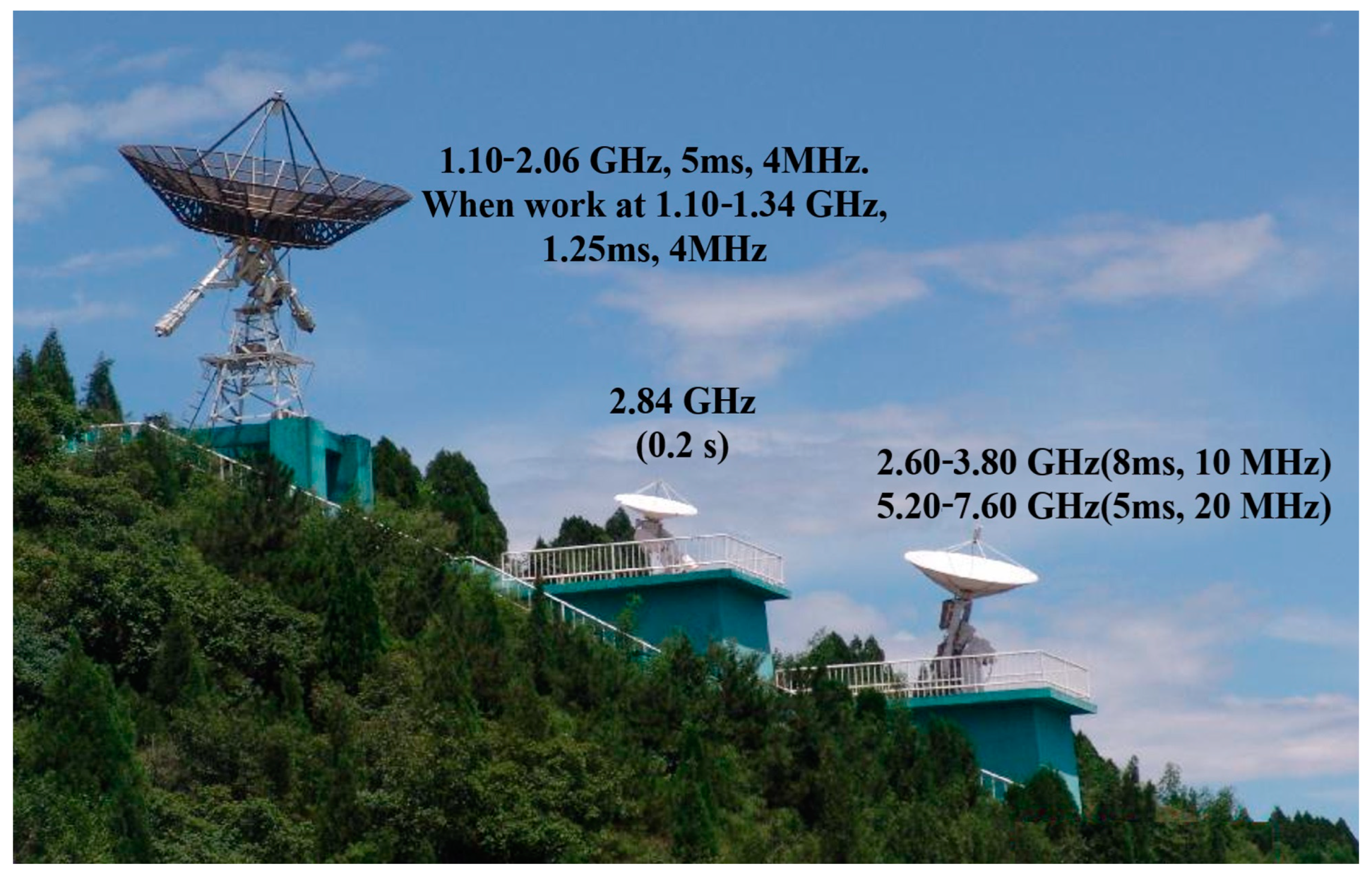

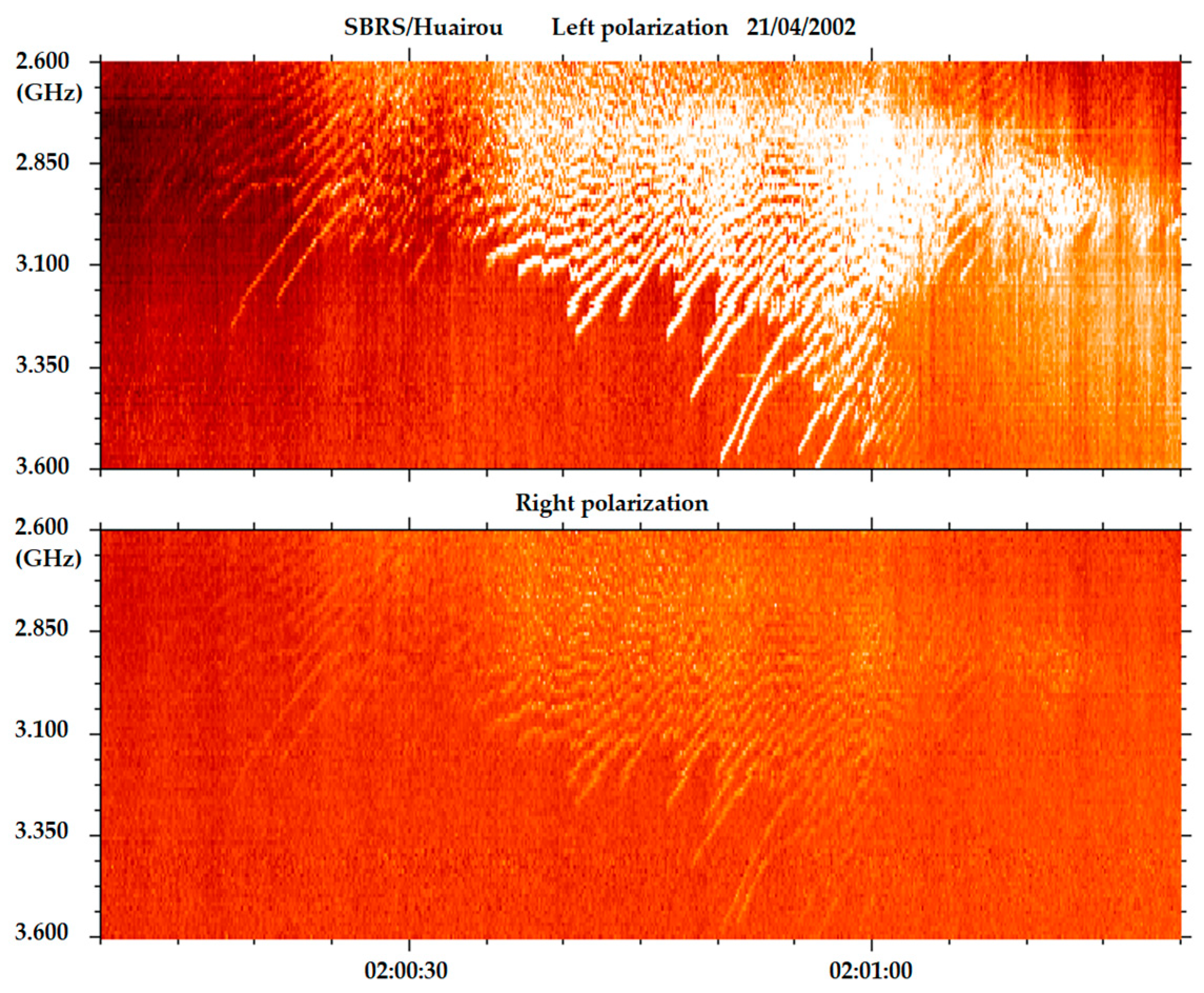

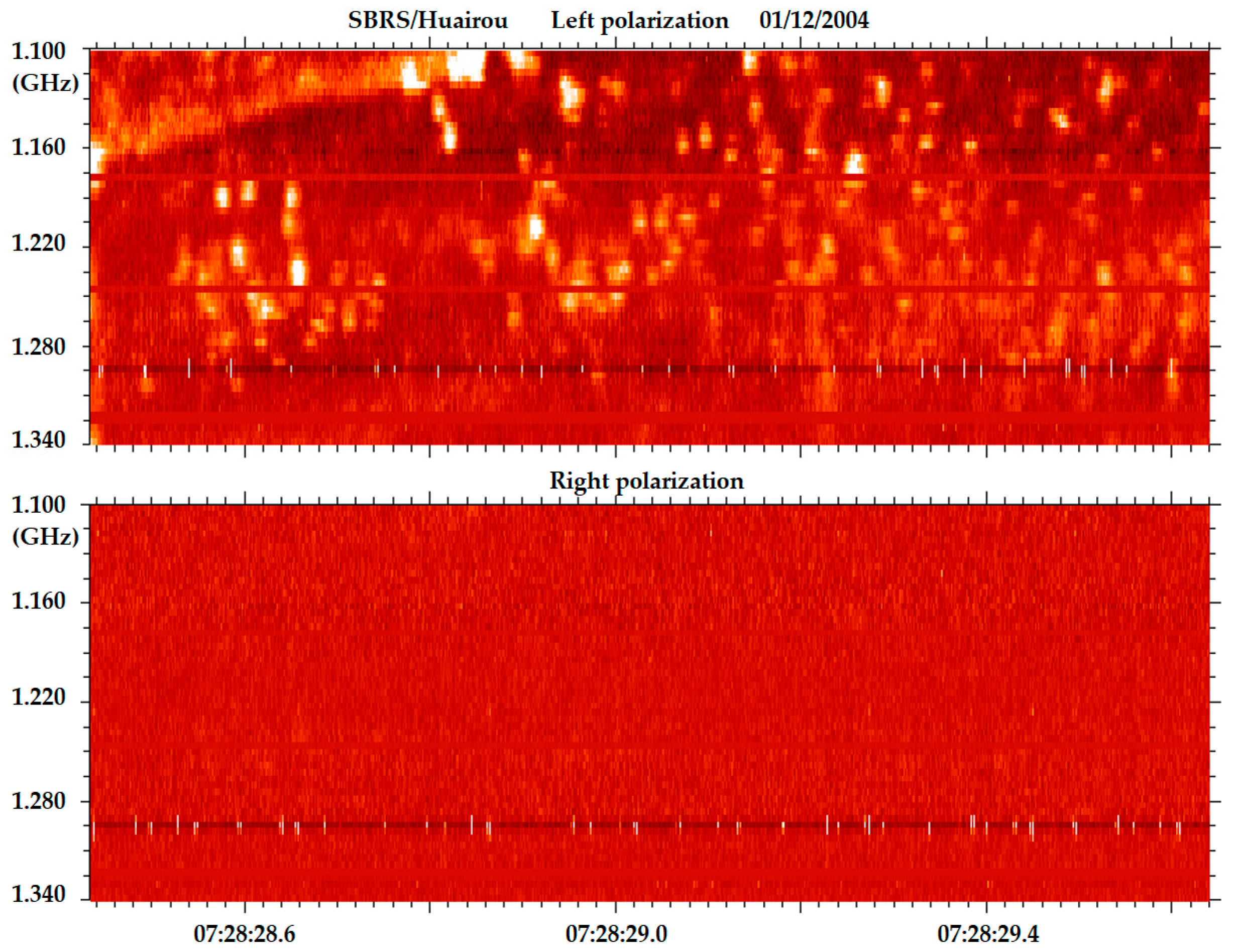
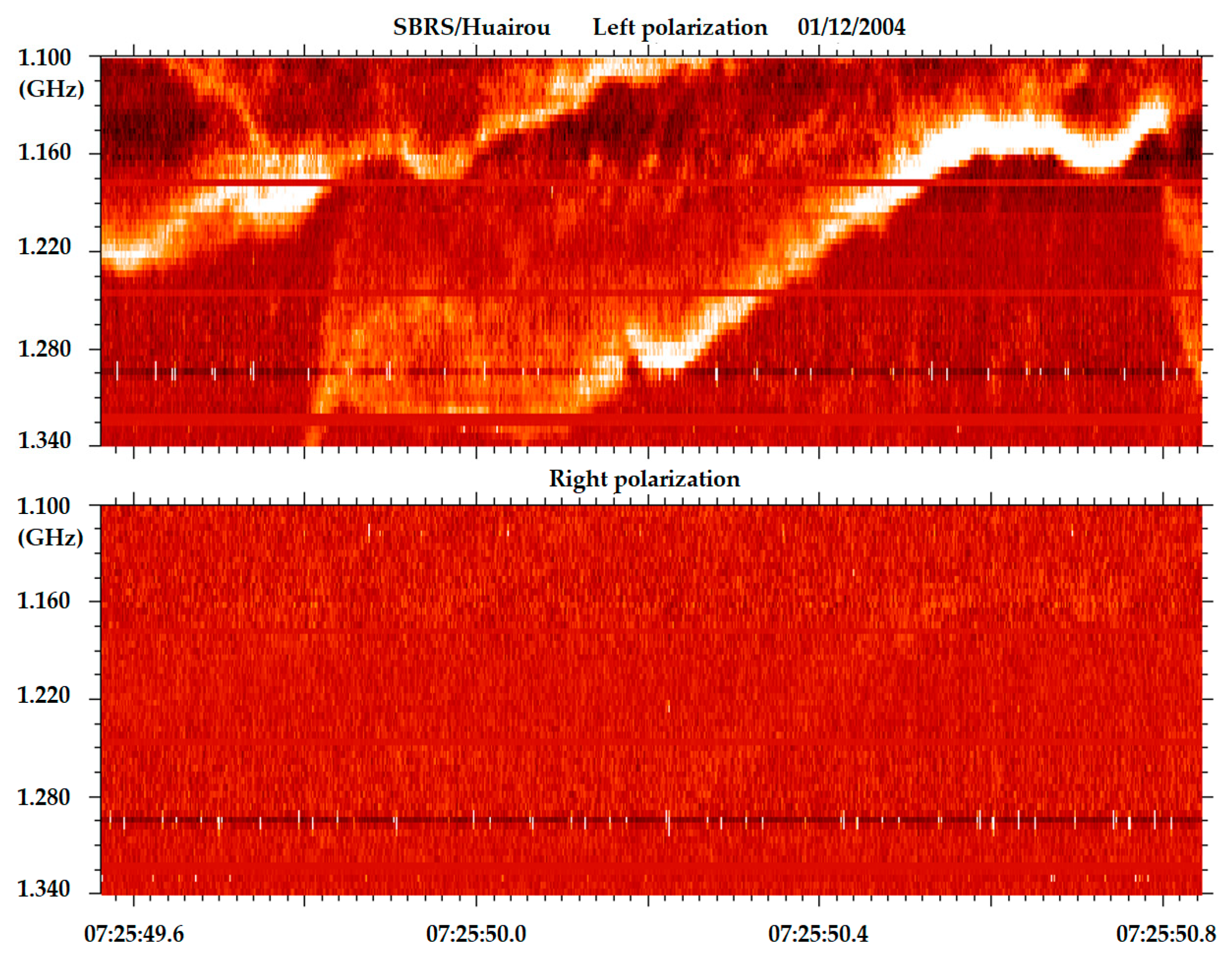
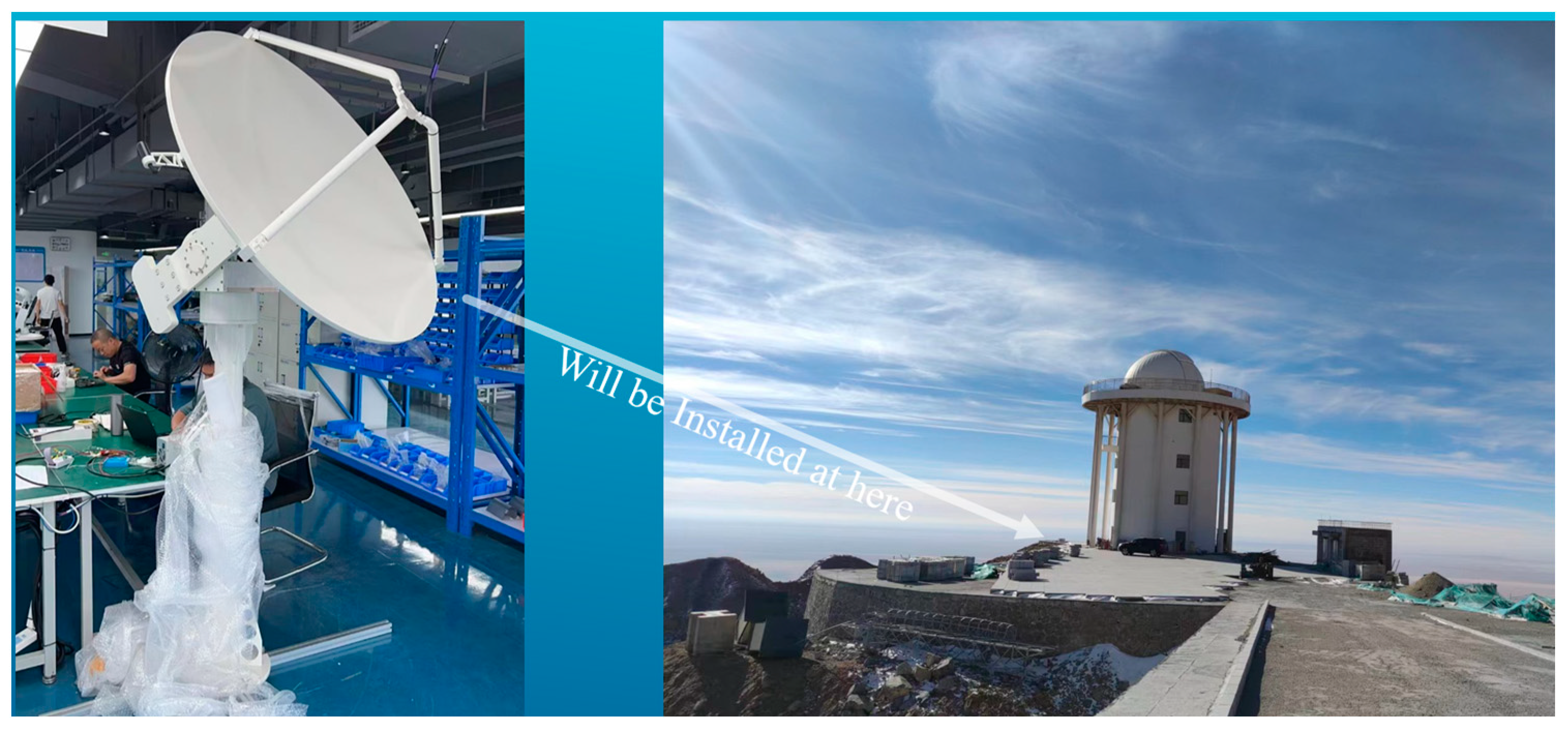
| Frequency (GHz) | Diameter of Antenna (m) | Δf (MHz) | Δt (ms) | Polarization Accuracy |
|---|---|---|---|---|
| 1.1–2.06 (1.10–1.34) | 7.3 | 4 | 5 (1.25) | <10% |
| 2.60–3.80 | 3.2 | 10 | 8 | <10% |
| 5.20–7.60 | 3.2 | 20 | 5 | <10% |
| 2.84 | 2.0 | MHz | 200 | <10% |
Disclaimer/Publisher’s Note: The statements, opinions and data contained in all publications are solely those of the individual author(s) and contributor(s) and not of MDPI and/or the editor(s). MDPI and/or the editor(s) disclaim responsibility for any injury to people or property resulting from any ideas, methods, instructions or products referred to in the content. |
© 2024 by the authors. Licensee MDPI, Basel, Switzerland. This article is an open access article distributed under the terms and conditions of the Creative Commons Attribution (CC BY) license (https://creativecommons.org/licenses/by/4.0/).
Share and Cite
Huang, J.; Tan, B. Radio Spectrum Observations and Studies of the Solar Broadband Radio Dynamic Spectrometer (SBRS). Universe 2024, 10, 440. https://doi.org/10.3390/universe10120440
Huang J, Tan B. Radio Spectrum Observations and Studies of the Solar Broadband Radio Dynamic Spectrometer (SBRS). Universe. 2024; 10(12):440. https://doi.org/10.3390/universe10120440
Chicago/Turabian StyleHuang, Jing, and Baolin Tan. 2024. "Radio Spectrum Observations and Studies of the Solar Broadband Radio Dynamic Spectrometer (SBRS)" Universe 10, no. 12: 440. https://doi.org/10.3390/universe10120440
APA StyleHuang, J., & Tan, B. (2024). Radio Spectrum Observations and Studies of the Solar Broadband Radio Dynamic Spectrometer (SBRS). Universe, 10(12), 440. https://doi.org/10.3390/universe10120440







